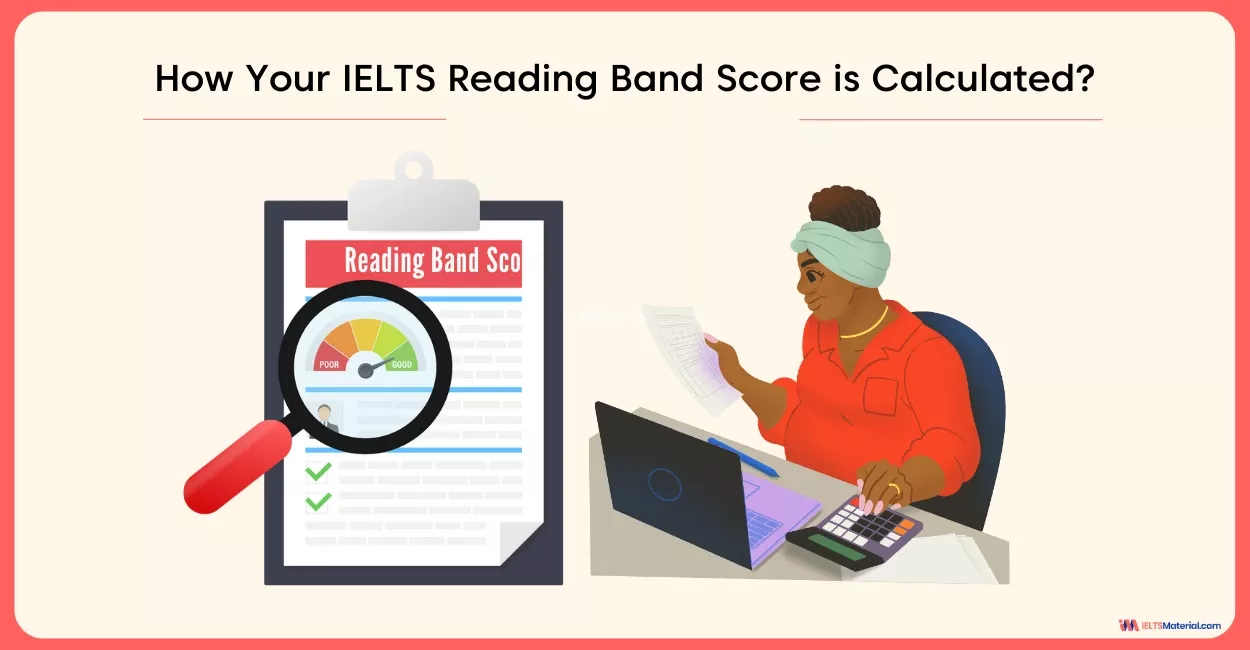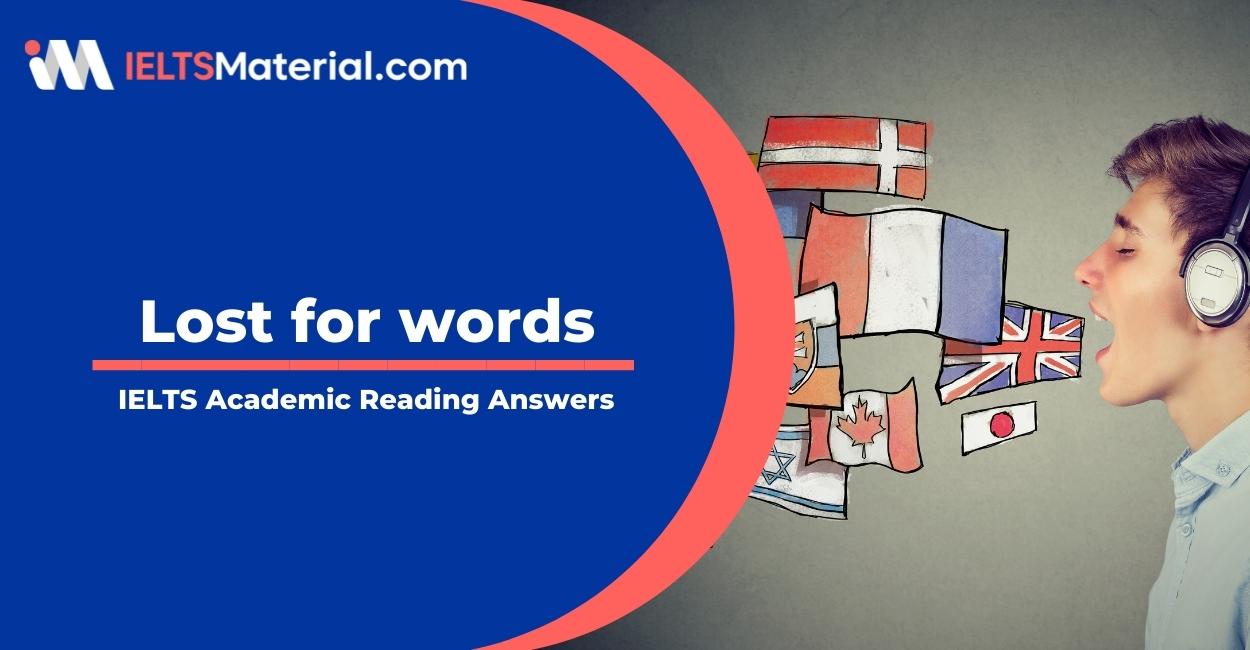Lost for Words IELTS Reading Answers
11 min read
Updated On
-
Copy link
Take the Lost for Words IELTS Reading Answers test and boost your reading skills for the IELTS exam. Also, find the answer explanations to prepare for handling these IELTS reading question types for a band 9 in the actual exam.
Table of Contents

Limited-Time Offer : Access a FREE 10-Day IELTS Study Plan!
The Academic passage, Lost for Words Reading Answers, is a reading passage that consists of 13 questions.
The IELTS Reading module can be the top-scoring category for IELTS aspirants with diligent practice. To score well, you must understand how to approach and answer the different question types in the Reading Module.
By solving and reviewing Sample Reading questions from past IELTS papers, you can ensure that your Reading skills are up to the mark. Take the reading passage, 'The Lost for Words' below and try more IELTS reading practice tests from IELTSMaterial.com.
Book a FREE Online Webinar with our IELTS experts to learn more tips and techniques for IELTS Reading!
Reading Passage
Lost for words
You should spend about 20 minutes on Question 1-13 which are based on Reading Passage below.
In the Native American Navajo nation, which sprawls across four states in the American south-west, the native language is dying. Most of its speakers are middle-aged or elderly Although many students take classes in Navajo, the schools are run in English. Street signs, supermarket goods and even their own newspaper are all in English. Not surprisingly, linguists doubt that any native speakers of Navajo will remain in a hundred years’ time.
Navajo is far from alone. Half the world’s 6,800 languages are likely to vanish within two generations - that’s one language lost every ten days. Never before has the planet’s linguistic diversity shrunk at such a pace. At the moment, we are heading for about three or four languages dominating the world,’ says Mark Pagel, an evolutionary biologist at the University of Reading. ‘It’s a mass extinction, and whether we will ever rebound from the loss is difficult to know.’
Isolation breeds linguistic diversity: as a result, the world is peppered with languages spoken by only a few people. Only 250 languages have more than a million speakers, and at least 3,000 have fewer than 2,500. It is not necessarily these small languages that are about to disappear. Navajo is considered endangered despite having 150,000 speakers. What makes a language endangered is not just the number of speakers, but how old they are. If it is spoken by children it is relatively safe. The critically endangered languages are those that are only spoken by the elderly, according to Michael Krauss, director of the Alassk Native Language Center, in Fairbanks.
Why do people reject the language of their parents? It begins with a crisis of confidence, when a small community finds itself alongside a larger, wealthier society, says Nicholas Ostler, of Britain’s Foundation for Endangered Languages, in Bath. ‘People lose faith in their culture,’ he says. ‘When the next generation reaches their teens, they might not want to be induced into the old traditions.’
The change is not always voluntary. Quite often, governments try to kill off a minority language by banning its use in public or discouraging its use in schools, all to promote national unity.
The former US policy of running Indian reservation schools in English, for example, effectively put languages such as Navajo on the danger list. But Salikoko Mufwene, who chairs the Linguistics department at the University of Chicago, argues that the deadliest weapon is not government policy but economic globalisation. ‘Native Americans have not lost pride in their language, but they have had to adapt to socio-economic pressures,’ he says. ‘They cannot refuse to speak English if most commercial activity is in English.’ But are languages worth saving? At the very least, there is a loss of data for the study of languages and their evolution, which relies on comparisons between languages, both living and dead. When an unwritten and unrecorded language disappears, it is lost to science.
Language is also intimately bound up with culture, so it may be difficult to preserve one without the other. ‘If a person shifts from Navajo to English, they lose something,’ Mufwene says. ‘Moreover, the loss of diversity may also deprive us of different ways of looking at the world,’ says Pagel. There is mounting evidence that learning a language produces physiological changes in the brain. ‘Your brain and mine are different from the brain of someone who speaks French, for instance,’ Pagel says, and this could affect our thoughts and perceptions. ‘The patterns and connections we make among various concepts may be structured by the linguistic habits of our community.’
So despite linguists’ best efforts, many languages will disappear over the next century. But a growing interest in cultural identity may prevent the direst predictions from coming true. ‘The key to fostering diversity is for people to learn their ancestral tongue, as well as the dominant language,’ says Doug Whalen, founder and president of the Endangered Language Fund in New Haven, Connecticut. ‘Most of these languages will not survive without a large degree of bilingualism,’ he says. In New Zealand, classes for children have slowed the erosion of Maori and rekindled interest in the language. A similar approach in Hawaii has produced about 8,000 new speakers of Polynesian languages in the past few years. In California, ‘apprentice’ programmes have provided life support to several indigenous languages. Volunteer ‘apprentices’ pair up with one of the last living speakers of a Native American tongue to learn a traditional skill such as basket weaving, with instruction exclusively in the endangered language. After about 300 hours of training they are generally sufficiently fluent to transmit the language to the next generation. But Mufwene says that preventing a language dying out is not the same as giving it new life by using it every day. ‘Preserving a language is more like preserving fruits in a jar,’ he says.
However, preservation can bring a language back from the dead. There are examples of languages that have survived in written form and then been revived by later generations. But a written form is essential for this, so the mere possibility of revival has led many speakers of endangered languages to develop systems of writing where none existed before.
Questions 1-4
Choose NO MORE THAN TWO WORDS from the passage for each answer. Write your answers in boxes 1-4 on your answer sheet.
There are currently approximately 6,800 languages in the world. This great variety of languages came about largely as a result of geographical (1)……………………..But in today’s world, factors such as government initiatives and (2)…………………..are contributing to a huge decrease in the number of languages. One factor which may help to ensure that some endangered languages do not die out completely is people’s increasing appreciation of their (3)…………………….This has been encouraged through programmes of language classes for children and through ‘apprentice’ schemes, in which the endangered language is used as the medium of instruction to teach people a (4)…………………….Some speakers of endangered languages have even produced writing systems in order to help secure the survival of their mother tongue.
Questions 5-9
Look at the following statements (Questions 5-9) and the list of people in the box below. Match each statement with the correct person A—E. Write the appropriate letter A-E in boxes 5-9 on your answer sheet.
NB You may use any letter more than once.
5 Endangered languages cannot be saved unless people learn to speak more than one language.
6 Saving languages from extinction is not in itself a satisfactory goal.
7 The way we think may be determined by our language.
8 Young people often reject the established way of life in their community.
9 A change of language may mean a loss of traditional culture
A Michael Krauss B Salikoko Mufwene C Nicholas Ostler
D Mark Pagel E Doug Whalen
Questions 10-13
Do the following statements agree with the views of the writer in the passage? In boxes 10-13 on your answer sheet write
YES if the statement agrees with the view of the writer
NO if the statement contradicts the view of the writer
NOT GIVEN if it is impossible to say what the writer thinks about this
10. The Navajo language will die out because it currently has too few speakers.
11. A large number of native speakers fails to guarantee the survival of a language.
12. National governments could do more to protect endangered languages.
13. The loss of linguistic diversity is inevitable.
Book a free demo class to master reading passages like ‘Lost for Words’ Join Now!
Lost for Words IELTS Reading Answers With Explanations
Unlock Answers
| Question Number | Answers | Explanation |
|---|---|---|
| 1. | isolation | Paragraph 3 points out that ‘isolation’ ‘breeds’ (came about largely) linguistic diversity (great variety of languages). As a result, the world is peppered with languages spoken by only a few people. Hence, the answer is ‘isolation’. |
| 2. | economic globalisation/globalization /socio-economic pressures | Paragraph 5 claims that quite often, governments try ‘to kill off a minority language’ (huge decrease in the number of languages). But Salikoko Mufwene, who chairs the Linguistics department at the University of Chicago, argues that the ‘deadliest weapon is’ not government policy but ‘economic globalisation’. He adds that Native Americans have not lost pride in their language, but they have had to ‘adapt to socio-economic pressures’ which has resulted in loss of their original languages. Hence, the answer is ‘economic globalisation/globalization /socio-economic pressures’. |
| 3. | Cultural identity | Paragraph 7 brings out the fact that a ‘growing interest’ (increasing appreciation) ‘in cultural identity’ may prevent the direst predictions of endangered languages from dying out completely. Hence, the answer is ‘cultural identity’. |
| 4. | Traditional skill | Paragraph 7 cites an example of New Zealand where language classes for children have slowed the erosion of Maori and ‘rekindled interest’ in the language. Moreover, in California, ‘‘apprentice’ programmes’ have provided life support to several indigenous languages. Volunteer ‘apprentices’ pair up with one of the last living speakers of a Native American tongue to ‘learn a traditional skill’ such as basket weaving, with instruction exclusively in the ‘endangered language’, that is, this endangered language is used as the medium of instruction to teach people/apprentices. Hence, the answer is ‘traditional skill’. |
| 5. | E | Paragraph 7 refers to the comment of ‘Doug Whalen’, founder and president of the Endangered Language Fund in New Haven, Connecticut, that the ‘key to fostering diversity’ is for people ‘to learn their ancestral tongue, as well as the dominant language’ (learn to speak more than one language). He adds that ‘most of these languages will not survive’ (will become endangered) without a large degree of ‘bilingualism (knowledge of two languages)’. Hence, the answer is ‘E’ (Doug Whalen). |
| 6. | B | The last sentence of paragraph 7 communicates Salikoko Mufwene’s belief that ‘preventing a language dying out’ (saving languages from extinction) ‘is not the same as giving it new life’, which is exciting and satisfactory. He further comments that ‘preserving a language is more like preserving fruits in a jar’, which is a very common action and does not add any extra satisfaction. Hence, the answer is ‘B’ (Salikoko Mufwene). |
| 7. | D | Paragraph 6 presents the fact that there is mounting evidence that learning a language produces physiological changes in the brain. ‘Mark Pagel’ says that ‘the patterns and connections we make among various concepts’, that is, the way we think ‘may be structured by’ (may be determined by) ‘the linguistic habits of our community’ (the language that we speak or the language of the community we live in). Hence, the answer is ‘D’ (Mark Pagel). |
| 8. | C | Paragraph 4 reveals that Nicholas Ostler, of Britain’s Foundation for Endangered Languages in Bath said that ‘people lose faith in their culture when the next generation reaches their ‘teens’ (young people of the new generation), they ‘might not want to be induced’ (reject or do not show any interest) into ‘the old traditions’ (the established way of life in their community). Hence, the answer is ‘C’ (Nicholas Ostler). |
| 9. | B | Paragraph 6 calls to attention the comment of Salikoko Mufwene that ‘language is also intimately bound up with culture’, so it may be ‘difficult to preserve one without the other’. From this comment we can conclude that he wants to say that if a change in the pattern of the language may lead to loss of the traditional culture associated with it. This view is supported by the example that he provides by saying that ‘if a person shifts from Navajo to English, they lose something’. Hence, the answer is ‘B’ (Salikoko Mufwene). |
| 10. | No | Paragraph 1 indicates that the native language of the American Navajo is dying. Most of its speakers are middle-aged or elderly. Although ‘many students take classes in Navajo’, which indicates that there are more than a few users of the language, the schools are run in English. Street signs, supermarket goods and even their own newspaper are all in English. Moreover, in paragraph 3, the writer has added that ‘Navajo is considered endangered despite having 150,000 speakers’ (a large number of speakers). So, the language will not die due to the number of speakers, rather it is dying as the young generation are educated in another language (English) and not in their native language. As the statement contradicts the views of the writer, the answer is ‘NO’. |
| 11. | Yes | In paragraph 3, the author has noted that ‘Navajo is considered endangered despite having 150,000 speakers’. This proves that even a large number of native speakers fail to guarantee the survival of a language. As the statement agrees with the views of the writer, the answer is ‘YES’. |
| 12. | Not Given | In paragraph 5, there is a reference to the government that they try to kill off a minority language by banning its use in public or discouraging its use in schools, all to promote national unity. Other than this, there is no mention of the role of the government to protect endangered languages. As it is impossible to say what the writer thinks about the statement, the answer is ‘NOT GIVEN’. |
| 13. | Yes | The first sentence of paragraph 7 mentions that despite linguists’ best efforts, ‘many languages will disappear’, that is loss of linguistic diversity is inevitable, over the next century. As the statement agrees with the views of the writer, the answer is ‘YES’. |
To conclude, we can say that IELTS Reading can be challenging. However, with proper preparation, common errors can be avoided. Additionally, expanding IELTS vocabulary, practicing different question types like the ones in 'Lost for Words' IELTS Reading Answers, and managing time efficiently are essential steps toward improvement.
Check More IELTS Reading Answers
Also check :
Practice IELTS Reading based on question types

Start Preparing for IELTS: Get Your 10-Day Study Plan Today!
Recent Articles

Nehasri Ravishenbagam

Haniya Yashfeen

Haniya Yashfeen

Haniya Yashfeen




Post your Comments